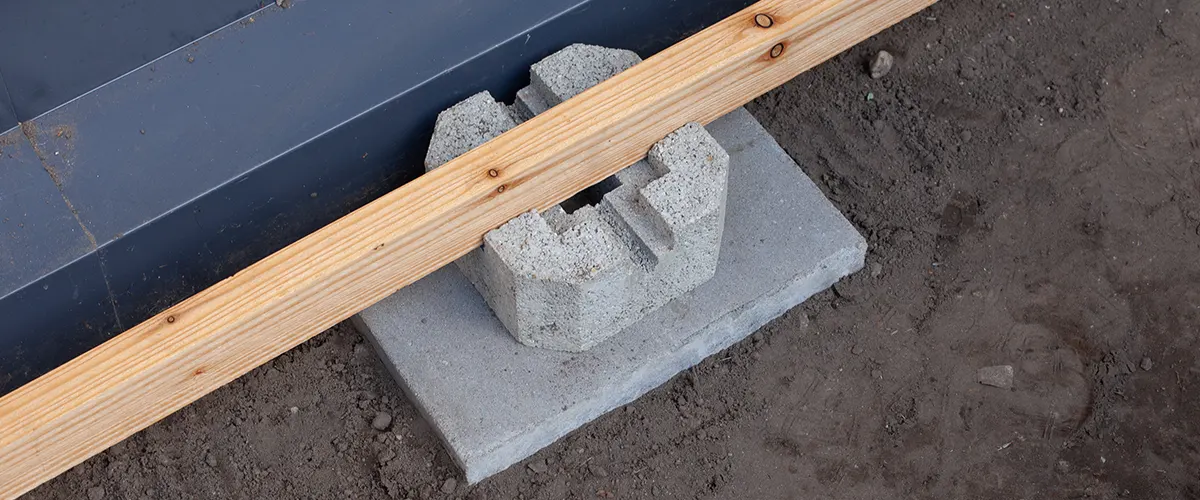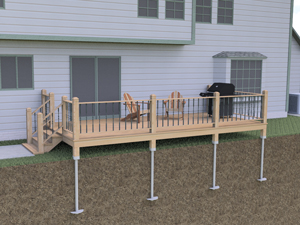Make Certain Stability and Long Life With Correctly Mounted Deck Footings
Deck grounds might not be the most extravagant element of deck building and construction, but they play an important role in making sure stability and durability. Effectively installed footings supply a solid foundation for your deck, stopping usual issues like sagging, moving, and also collapse. Selecting the ideal kind of ground and correctly installing it can be a complicated procedure. In this conversation, we will certainly discover the importance of proper deck footings, elements to consider during setup, different kinds of footings available, detailed setup guide, and upkeep ideas for making sure lasting footings. So, if you intend to make certain the stability and longevity of your deck, keep checking out to uncover the crucial understandings to attain a sturdy and structurally audio exterior space.

Significance of Correct Deck Grounds
Why are correctly mounted deck footings important for the security and long life of your deck? Deck grounds are the structure on which the deck relaxes, transferring the tons from the deck to the ground.
First of all, correctly installed deck grounds disperse the weight of the deck equally, stopping any type of unequal settling or sinking. This is particularly important in locations with unpredictable soil, as it assists to reduce the risk of the deck shifting or falling down. Additionally, well-installed grounds make certain that the deck stays level, preventing any kind of architectural damage that can occur when a deck comes to be unequal.
Secondly, properly mounted footings give a strong support for the deck, protecting against too much activity and persuade. This helps to maintain the architectural honesty of the deck, lowering the danger of crashes or injuries. It additionally decreases the deterioration on the deck, allowing it to hold up against the elements and normal use for a longer time period.
Aspects to Consider for Deck Ground Installation
When setting up deck grounds, there are a number of essential factors to consider for correct installment. Different soil kinds have various load-bearing capacities, so it is crucial to perform a dirt test to guarantee the grounds can sustain the weight of the deck and its residents. By taking into account these variables, you can make sure the proper installation of deck footings and delight in a stable and long-lasting deck.
Types of Deck Grounds to Pick From
There are a number of different kinds of deck footings available for you to select from. Each type has its very own advantages and negative aspects, so it's vital to consider your certain needs and the problems of your deck before deciding.
One usual type of deck footing is the concrete ground. This entails excavating holes in the ground and putting concrete right into them to produce a solid structure. Concrete grounds are resilient and offer excellent security, making them ideal for decks in areas with challenging dirt conditions or high wind loads.
One more option is the helical pier footing, which contains a steel shaft with helical plates that are screwed into the ground. These grounds are fast to install and can be used in numerous soil types, consisting of sandy or clay dirts. They are likewise flexible, permitting very easy progressing of the deck.
Sonotube footings are an additional prominent choice. These grounds are produced by positioning a cardboard tube in an opening and filling it with concrete. Sonotube grounds are relatively very easy to install and give adequate security for smaller decks or in locations with less requiring soil problems.

When picking the kind of deck ground, it's critical to think about aspects such as soil conditions, deck size and weight, local building ordinance, and individual choices. By choosing the suitable footing type, you can ensure the security and longevity of your deck.
Step-by-Step Overview for Putting Up Deck Footings

Figure out the area: Begin by marking the specific position of each footing utilizing risks and string (Deck Footings). Take into account any type of neighborhood building regulations or policies relating to setback ranges
Dig the openings: Use a message opening miner or an auger to dig the openings for the footings. The depth will depend upon the frost line in your location and the kind of dirt. Generally, a depth of at the very least 36 inches is recommended for stability.
Degree the holes: Guarantee that the bases his explanation of the openings are degree (Deck Footings). This can be accomplished by utilizing a degree or a straight board throughout the top of the openings
Include crushed check out this site rock: Area a layer of crushed rock at the base of each opening to improve drainage and prevent the footing from sinking into the soil over time.
Insert the footing forms: Insert the footing creates right into the openings, guaranteeing they are focused and degree. Usage risks to protect them in position.
Mix and pour concrete: Follow the instructions on the concrete mix bag to prepare the concrete. Pour the concrete right into the ground kinds, loading them totally.
Smooth the surface: Use a trowel to smooth the surface of the concrete and remove any air pockets. Allow the concrete to heal according to the supplier's directions.
Maintenance Tips for Lasting Deck Footings
Correct upkeep is critical for making certain the durability and stability of deck grounds. By consistently evaluating and preserving your deck footings, you can prevent damages and prospective safety threats. One crucial aspect of maintenance is to consistently examine for any kind of indications of wear and tear, such as splits or motion in the footings. If you see any concerns, it is very important to address them immediately to avoid more damage.
Regular cleansing is additionally vital for keeping deck footings. Dirt, vegetation, and debris can gather around the footings, which can result in moisture buildup and decay. Cleaning up the footings on a regular basis, making use of a stress or a brush washer, can assist prevent these concerns and extend the life-span of your deck.
Along with cleaning, it is important to maintain the location around the grounds free from any kind of obstructions. Avoid stacking items against the footings or enabling plants to expand also near them. These blockages can catch dampness and create the grounds to deteriorate over time.
Lastly, regular resealing of the footings is recommended to safeguard them from wetness and other ecological aspects. Using a water-proof sealer can assist stop water damage and extend the lifespan of the footings.
Conclusion
In conclusion, correct installment of deck grounds is critical for ensuring stability and longevity of your deck. website link Factors such as dirt kind, tons capacity, and local building regulations require to be taken into consideration when selecting the best kind of deck grounds. Adhering to a step-by-step overview for setup and routine maintenance will certainly assist to guarantee the footings continue to be long-lasting and sturdy.
In this conversation, we will discover the value of appropriate deck footings, factors to take into consideration during installation, various types of grounds offered, detailed setup guide, and upkeep tips for making certain resilient footings. Deck footings are the structure on which the deck rests, moving the load from the deck to the ground.One usual type of deck ground is the concrete footing. Put the footing kinds: Insert the ground forms right into the holes, guaranteeing they are focused and level.In final thought, proper setup of deck grounds is vital for ensuring security and longevity of your deck.